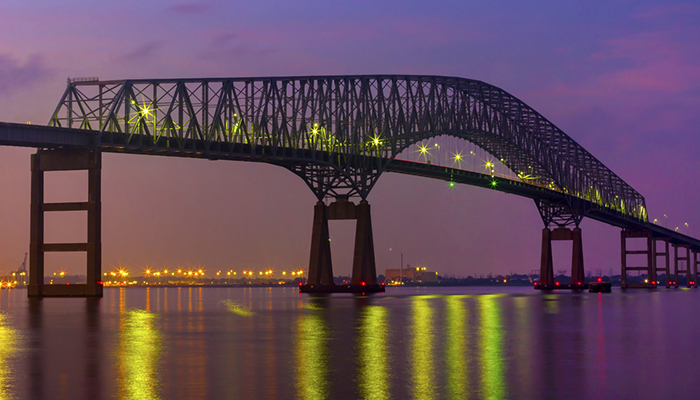Baltimore bridge collapse losses could run into billions: Sources
Reinsurers will bear the brunt of the losses from the collapse of the Francis Scott Key Bridge, AM Best says

The collapse of the Francis Scott Key Bridge in Baltimore after it was struck by a container ship could trigger a wide swath of insurance and reinsurance policies, and the loss is likely to run into billions of dollars and trigger reinsurance claims, sources say.
Beyond marine hull, cargo and liability policies, the incident could trigger various coverages, including auto, contingent business interruption, inland marine, property, trade credit and workers compensation.
The Singapore-flagged Dali container ship, owned by Grace Ocean Pte Ltd, collided with one of the pillars of the bridge, at around 1:30 am ET on Tuesday while being piloted.
At least two people were rescued, and a further six people missing in the water are now presumed to have died, according to news reports. Several vehicles, as well as contractors, were reported on the bridge when it collapsed.
The bridge, which provided access to the Port of Baltimore, opened in 1977. The port is the largest for shipments of cars and light trucks in the US.
London-based marine mutual insurer The Britannia P&I Club confirmed that the Dali is insured by the club for protection and indemnity liabilities. The vessel will also have hull and cargo coverage in place, sources said.
All 22 crew members on board, including two pilots, have been accounted for and there are no reports of any injuries among them, the owners and managers of the ship said.
In a statement, Synergy Marine Group, the vessel’s manager, said the owners and managers are fully cooperating with federal and state agencies. The exact cause of the incident has yet to be determined, they said, adding that there had been no pollution.
News reports said the ship may have lost steering after losing power before hitting the bridge. The bridge is valued upwards of $1.2bn, though it is not known whether the insured limit on the property placement is that high, the Insurance Information Institute said. It is understood that Aon handles the bridges and tunnels property placement for the state of Maryland.
Britannia Club is a member of the International Group of P&I clubs, an association of 12 P&I clubs that provides marine liability cover for 90% of the world’s ocean-going tonnage.
Individual clubs retain $10m on any claim, and claims in excess of $10m are shared between the group clubs. The group also buys group excess of loss reinsurance cover up to $3.1bn in the open market. AXA XL leads the group excess of loss cover, according to information posted on the International Group’s site.
Excess of $30m, the International Group pool is also reinsured by Bermuda-domiciled group captive Hydra Insurance Co Ltd, an incorporated cell company. Each of the 12 Group clubs has its own segregated account or cell ringfencing its assets and liability from the other club cells.
The total cost of the bridge collapse and associated claims will not be clear for some time but is likely to run into billions of dollars and “well above the $100m attachment point for the GXL contract”, rating agency AM Best said, adding that “reinsurers will bear the bulk of the insured cost of the collapse of the Francis Scott Key Bridge.”
“The insurance issues due to the collapse of the bridge will take a long time to unravel and may involve several lines, such as property, cargo, liability, trade credit and contingent business interruption,” Best said.
“I would expect this event to exhaust limits, excess layers and reinsurance for most types of coverage carried by the ship’s operator,” Robert Hartwig, clinical associate professor and director, Risk and Uncertainty Management Center, at the University of South Carolina’s Darla Moore School of Business, said in an email.
The disruption to vehicle and marine traffic could lead to contingent business interruption claims in the US and abroad, Hartwig said.
Litigation against the entity responsible for the operation and maintenance of the bridge is also possible, he said.
“The claim will likely involve several insurers, reinsurers, subrogation and legal issues, and will serve to add to the increasing challenges in reinsurance availability,” Best said.
Depending on the duration of shipping interruption, this will likely push replacement costs up for new autos — at least in the short run, the Insurance Information Institute said.
The Dali, en route from the port of Baltimore to Colombo, Sri Lanka, was chartered by Denmark-based AP Moeller Maersk and carrying Maersk customers’ cargo.
None of its personnel were onboard, Maersk said. “Please note that for cargo set to discharge in Baltimore, delays may occur, as they will need to discharge in other ports,” Maersk said in an advisory to customers.
Maersk has a Denmark-domiciled captive insurer, Maersk Insurance A/S, that is licensed to write direct and reinsurance business for various insurance lines including marine, property and liability.
The 984-foot (300 meters) cargo ship had a capacity of 10,000 TEU – 20-foot equivalent unit, a measure of a ship’s cargo capacity – and 4,679 boxes onboard.
A 10,000 to 20,000 TEU is considered to be a very large container ship. In recent years, concerns have been raised over the growing capacity of container vessels and the increasing cargo accumulations and exposures for insurers.
Allianz Global Corporate & Specialty, a unit of Allianz, warned in a report last year that some insurers may scale back their exposure to larger container vessels if the associated risks are not properly managed.
This article first appeared on our sister website Business Insurance. For further news from Business Insurance, please click here.
No comments:
Post a Comment